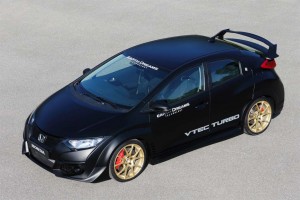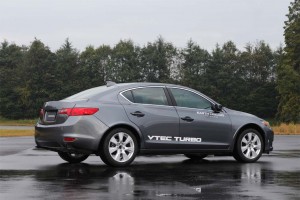
Honda has big plans for its three new turbo engine packages, including a 2.0-liter I-4 that will go into Europe's Civic Type R for 2015.
As its middle name was meant to attest, Honda Motor Co. has always put a premium on powertrain technology – though until recently, it has emphasized naturally aspirated gasoline engines and basic hybrid systems. But that is changing fast.
Already in the midst of rolling out a trio of new hybrid drivetrains, Honda also is pushing forward with turbocharging, senior company officials announced, during a media tour of the maker’s Tochigi R&D center and corporate headquarters where they showed off three downsized turbo engine packages. Turbos will soon be used in a wide variety of the maker’s products, from the little Fit all the way up to the new Acura NSX supercar.
The three new turbo engines will be paired with an assortment of new transmissions, including Honda’s latest CVT and an all-new 8-speed dual clutch, or DCT, being developed to blend the smoothness of an automatic, the performance of a manual and the fuel economy of a CVT.
Along with the launch of the three conventional hybrid systems, the plug-in hybrid now used in the Honda Accord and the battery-electric version of the Fit, Honda powertrain engineers are stretched thin, conceded Tetsuo Iwamura, the Chief Operating Officer for American Honda as well as the COO of Honda Motor’s global automotive operations. That’s one reason why the maker is reluctant, right now, to commit to developing a diesel engine for the U.S. market.
In one sense, Honda’s turn to turbocharging should come as no surprise. The technology has been rapidly gaining ground in the global auto industry as manufacturers look to address seemingly disparate goals: both boosting performance while also improving fuel economy.
(Honda offers first close-up look at new Acura NSX hybrid drive system. Click Here to check it out.)
By 2017, turbo supplier Honeywell Transportation Systems recently forecast, the technology is likely to be used on 36 million vehicles annually – about 40% of the project global automotive production for that year. Volkswagen recently revealed plans to go a virtually all-turbo powertrain model within the next few years, and other makers, such as Ford – with its EcoBoost engine family – are not far behind.
But Honda, despite its reputation for developing some of the industry’s most sophisticated engines, has long steered clear of turbocharging. It has offered a boosted package in only one key model, the Acura RDX, and according to Iwamura, that was done primarily to “differentiate” the smaller crossover from the brand’s bigger MDX model.
(Honda to debut hydrogen car at LA Auto Show. Click Here for a sneak peek.)
Going forward, turbos will play a much more significant role in the Honda line-up and officials like Iwamura hope they will help pump a little emotion into a brand that has drifted towards the less passionate mainstream in recent years.
The first of the new models to market will be the Honda Civic Type R set to debut for the 2015 model-year, with Honda officials openly discussing a U.S. version, as well. The powerplant could very well show up in the entry-luxury Acura ILX, as well.
The Civic Type R will be equipped with a 2.0-liter inline-four making at least 280 horsepower. But two smaller turbo engines will follow, including a 1.5-liter I-4 and a 1.0-liter three-cylinder package. All three versions share a number of key features developed by Honda including a unique piston cooling system that the maker claims can reduce both smog-causing NOx and performance-robbing knocking.
(New studies list Honda among best brands for holding resale value. Click Herefor more.)
While Honda isn’t committing to an all-turbo line-up, like Volkswagen, Iwamura said the new technology will be used “as much as possible.” In fact, Acura will use a special turbocharged version of a bigger V-6 at the heart of its new Acura NSX supercar. It will be paired with a three-motor hybrid drive system.
The turbocharged engines will allow Honda to downsize its powertrain line. The 1.5-liter I-4, for example, will replace the maker’s naturally aspirated 1.8-liter engine and while yielding 45% more torque, the smaller alternative will also deliver 15% better fuel economy.
The challenge, stressed Iwamura and other Honda officials, is that emissions and fuel economy standards are rapidly increasing all over the world and that will require major changes that likely will include the use of lighter materials like aluminum and carbon fiber-reinforced plastics. Among the many steps Honda is exploring, the maker revealed a prototype version of its CR-Z coupe using a CFRP platform that shaves 100s of pounds off the weight of the current model.
But powertrain technology is where Honda hopes to achieve gains fast. And it’s not just with new hybrid and turbocharged engines. The maker has been rapidly adopting new CVT gearboxes but will also add two DCT transmissions. It has already shown off a seven-speed and during the Tochigi background session revealed an eight-speed dual clutch that Honda claims could improve fuel efficiency by up to 8% even while acceleration improves by at least 10%.
DCTs have had their challenges, however, and mainstream consumers often complain about launch feel that isn’t quite up to the smoothness of a conventional automatic. Honda believes it has solved that problem by integrating an automatic’s torque convertor used only as the vehicle starts up.
Honda has still more powertrain technologies in the works. Later this week it will unveil an all-new hydrogen fuel-cell vehicle prototype at the L.A. Auto Show, a concept vehicle that it hopes to put into production in 2015.
“We believe the ultimate form of personal mobility would a hydrogen fuel-cell vehicle,” Honda Motor Co. CEO Takanobu Ito said during a media roundtable in Tokyo.
Honda has also been investing in diesel power for its European line-up, a powertrain option essential in a market where so-called “oil-burner” technology accounts for roughly half of all new vehicle sales. But auto operations COO Iwamura cautioned that despite growing interest, Honda is not ready to commit to bringing a diesel over to the U.S. market. It would be costly to meet American emissions mandates, he stressed, and Honda’s engineering teams are already stretched thin, meaning diesel will have to be put on hold, at least for now.


All large volume car makers who sell in the U.S. are being forced into small, turbo engines to try and meet impossible and irresponsible 54.5 mpg CAFE requirements.
“Impossible”? “Irresponsible”? Isn’t it even more irresponsible to do nothing? History has shown that, absent government mandates to improve things like safety and fuel economy, manufacturers will pursue their own agendas, which have more to do with selling cars than making them either safer or more fuel-efficient. And history has also shown that necessity is the mother of invention, which makes it more likely than not that a 54.5 MPG CAFE requirement is absolutely possible.